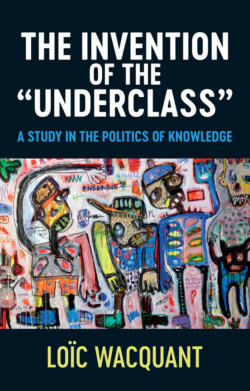Читать книгу The Invention of the 'Underclass' - Loic Wacquant - Страница 18
ОглавлениеEntry
A new social animal burst upon the American urban landscape at the close of the 1970s and soon sowed fear and loathing among the citizenry as well as caused spiking worry among public officials. Its discovery triggered a veritable media tsunami: major national outlets devoted lurid articles, fulminating editorials and alarming reports on the noxious and predatory behaviors alleged to characterize it. Politicians of every stripe rushed to denounce its sinister presence at the heart of the metropolis, in which they detected now the symptom, now the cause of the unraveling of the derelict districts that disfigured the nation’s major cities. Social scientists and public policy experts were summoned to establish its geographic location, to specify its social habitat, to enumerate its ranks, and to elucidate its mores, so that the means by which to contain its malignant proliferation might be urgently devised. Legislative hearings were held, academic conferences organized, and scholarly tomes and popular accounts proliferated apace.1
Figure 1 Cover of Time Magazine in the wake of the “Harlem blackout riot” of August 1977
That animal is the urban “underclass,” a term with woolly contours and sulfurous connotations (see box “A nebulous term” on pp. 31–2) that is best kept in quotation marks since it refers to a sociosymbolic constellation peculiar to the United States of the two decades following the New York City blackout riots of July 1977 that prompted Time Magazine to devote its cover to this fearsome “minority within a minority” (see figure 1). As we shall see, it has no real precedent in American history due to the triple stigma of class, caste, and place it carries and no counterpart in Western European countries owing to the deep differences in the manner in which these two continents conceive urban marginality and treat it politically.2
Indeed, the “underclass” is neither the “subproletariat” of Marxist theory (for the term itself is misleading on that count; it is not a class), nor the “fourth-world” of the sociology of poverty inspired by reformist Catholicism (it is the object of scorn and terror rather than compassion), nor the “new poor” or the “excluded” figuring prominently in the contemporaneous European debates on urban inequality (the first term was briefly in fashion at the start of the 1960s, the second is largely absent from the American vocabulary on the topic).3 It is a diffuse and motley aggregate – “a mishmash of social misfits,” concludes sociologist Carole Marks upon conducting a broad-ranging survey of extant scholarly studies on the question4 – composed of fundamentally incongruous categories that owe being lumped together thus to the simple fact that they are perceived as a menace, at once physical, moral, and fiscal, for the integrity of urban society.
A nebulous term with “evil” connotations
“The term is powerful because it calls attention to the conjunction between the characters of individuals and the impersonal forces of the larger social and political order. ‘Class’ is the least interesting half of the word. Although it implies a relationship between one social group and another, the terms of that relationship are left undefined until combined with the familiar word ‘under’. This transformation of a preposition into an adjective has none of the sturdiness of ‘working’, the banality of ‘middle’, or the remoteness of ‘upper’. Instead, ‘under’ suggests the lowly, passive, and submissive, yet at the same time the disreputable, dangerous, disruptive, dark, evil, and even hellish. Apart from these personal attributes, it suggests subjection, subordination, and deprivation. All these meanings are perhaps best brought together in Richard Wagner’s The Ring of the Nibelung. Wotan goes under the earth to wrest the ring from the malicious Alberich, who had used it to enslave a vile and debased subhuman population.”
Paul Peterson, Henry Shattuck Professor of Government at Harvard University and Chair of the Committee for Research on the Urban Underclass at the Social Science Research Council, reporting approvingly the findings of a major conference on the topic (in Jencks and Peterson,
The Urban Underclass, 1991, p. 3).
Notes
1 1. It would take a booklet to simply list all the print articles, television reports, and academic publications devoted to the “underclass” during the two decades covered here (1977–1997). A quick tour giving the reader an idea of the intensity and diversity of concerns covered by this umbrella term in journalism includes Ken Auletta, The Underclass (1982); Chicago Tribune, The American Millstone: An Examination of the Nation’s Permanent Underclass (1986); Myron Magnet, The Dream and the Nightmare: The Sixties Legacy to the Underclass (1993); and Peter Davis, If You Came This Way: A Journey Through the Lives of the Underclass (1995). A panel of scholarly views is Christopher Jencks and Paul E. Peterson (eds.), The Urban Underclass (1991); William Julius Wilson (ed.), The Ghetto Underclass: Social Science Perspectives (1993a); Michael B. Katz (ed.), The “Underclass” Debate: Views from History (1993a); and William A. Kelso, Poverty and the Underclass: Changing Perceptions of the Poor in America (1994). The tortuous interface between academic, journalistic, and policy views is captured live in Joint Economic Committee, The Underclass, Hearing Before the Joint Economic Committee of the 101st Congress of the United States (1989), which I dissect in chapter 2.
2 2. Alberto Alesina and Edward L. Glaeser, Fighting Poverty in the US and Europe: A World of Difference (2004), and Jonas Pontusson, Inequality and Prosperity: Social Europe vs. Liberal America (2005).
3 3. On the “subproletariat,” see Pierre Bourdieu, Algérie 1960. Structures économiques et structures temporelles (1977); the concept of “quart-monde” is elaborated by Jean Labbens, Le Quart-monde. La condition sous-prolétarienne (1969), and idem, Sociologie de la pauvreté. Le tiers-monde et le quart-monde (1978). The parallel rising popularity of “exclusion” in Europe is attested by Graham Room (ed.), Beyond the Threshold: The Measurement and Analysis of Social Exclusion (1995), and Serge Paugam, (ed.), L’Exclusion. L’état des savoirs (1996).
4 4. Carole Marks, “The Urban Underclass” (1991), p. 462.
